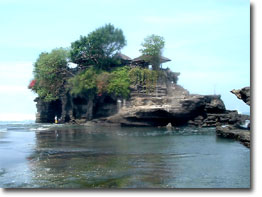 Bali,
Island of The God Bali,
Island of The God
Over
the years, the grace and charm of Bali and its people have earned
this tiny Indonesian island numerous sobriquets of praise and
homage including Island of the Gods, The Last Paradise, Land
of a Thousand Temples, and Morning of the World. Generations
of foreign visitors, mesmerized by the placid lifestyles and
fantastic rituals of the gregarious Balinese, have sought to
capture the island's spirit with poetic labels such as these.
Yet
it is Bali that does the capturing. Covering less than 6,000
km2 with an estimated population of 2.7 million people, this
lush, diamond-shaped island attracts over one million tourists
a year, each drawn by the promise of a paradise on earth.
Most of them seek an understanding of a way of life that is
truly unique. The capital city of Bali's province is Denpasar,
with a population of approximately 300,000. The second largest
town is Singaraja, which is located in the north. The most
attractive tourist area is Kuta beach, which is only a 15
minutes drive from the International Ngurah Rai Airport. Bali
today is divided administratively between eight regencies
that take their names and boundaries from the island's old
Hindu kingdoms; Badung, Bangli, Buleleng, Gianyar, Jembrana,
Karangasem, Klungkung and Tabanan.
This
is a land of startling geographical contrasts, of verdant
rice terraces and sacred, mist-wreathed volcanoes, of white-sand
beaches and dense tropical rainforest. This is home to one
of the world's most vibrant cultures, a society famed for
its dance and music, its lavish ceremonies and artistic achievements.
Temples, shrines and antiquities are an equally ubiquitous
part of Bali's cultural landscape (there are over 11,000 such
structures on the island), with memorable sites including
the cliff-side sanctuary of Uluwatu, the holy spring of Tirta
Empul and the ancient hermitage of Goa Gajah
Dance is a part of Balinese life. This can be watched in every
cultural or religious activity. The most common and attractive
dances are the Barong and Kecak. The dances are performed daily
in several places around Ubud and Singapadu. There are several
other dances that could excite you such as the Gambung, the
Topeng, the Baris, and the Legong.
The shoppers among you will find Bali a treasure chest of gifted
artists and craftsmen, and their material creations are imbued
with the same sense of wonderment with which they regard their
universe. Stone and woodcarvings, traditional and modern paintings
and intricately designed jewelry in gold and silver are readily
available in shops and galleries throughout the island, particularly
along the road to Ubud.
As
for recreation, there is no shortage of options. The resort
hotels of Kuta, Sanur and Nusa Dua offer all the comforts
and amenities that international travelers have come to expect.
Eating is also a distinct treat on Bali, with a huge number
of open-air cafes and restaurants serving just about every
cuisine imaginable. While food stalls and hawker stands are
not recommended for reasons of hygiene, you should have no
problem finding a delicious meal and great service in or outside
of your hotel. When dinner is over, a dazzling array of bars,
clubs and discos take over to keep you entertained well into
the night.
|



